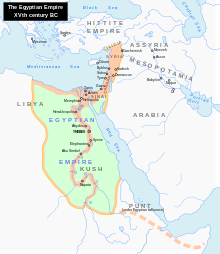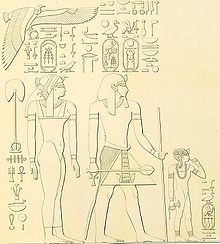Thutmose I.
| Name of Thutmose I. | |||||||||||||||||
|---|---|---|---|---|---|---|---|---|---|---|---|---|---|---|---|---|---|
| Horus name |
K3-nḫt-mrj-m3ˁt Strong bull, lover of the mate |
||||||||||||||||
| Sideline |
Ḫˁj-m-nsrt-ˁ3-pḥtj Who appears with / in the snake goddess, with great power |
||||||||||||||||
| Gold name |
Nfr-rnpwt-s-ˁnḫ-jb.w With beautiful years, which lets the hearts live |
||||||||||||||||
| Throne name |
ˁ3-ḫpr-k3-Rˁ Large in shape and Ka , a Re |
||||||||||||||||
| Proper name |
(Djehuti mes) Ḏḥwtj msj (w) Thot is born |
||||||||||||||||
| Greek |
Manetho variants: Josephus : Mephres Africanus : Misaphris Eusebius : Miphres Eusebius, A version: Memphres |
||||||||||||||||
Thutmose I was the third ancient Egyptian king ( Pharaoh ) of the 18th Dynasty ( New Kingdom ) and ruled from around 1504 BC. Until around 1492 BC It is very likely that his portrait is depicted in the image of a king making sacrifices .
Other names
- Epithet to throne name : From Re of created / Chosen / Great Pulled; Sign / plan of Amun .
- Horus-Name (further variation): Strong bull of Re or lover of Re, who appears with the white crown.
- Nebti name : The one who appears with / in the snake goddess, with great power (Varies: who conquers all countries, or who praises Atum, with manifest appearances).
- Gold names : With beautiful years that let the hearts live (Varies: Whostrikesthe nine arches , or with great strength and abundant clout, with prosperous years in the great house of mates ).
- On a stele , which is in the Louvre today, the following title is given for this regent: "Meri-Min-Hor- Nacht " ( Mr.j-Mn-Ḥr. (W) -nḫt ); Loved by Min-Hor-Nacht ; where the term "Min-Hor-Nacht" represents a special form of the god Horus or Min , which was especially venerated in Abydos .
family
- Father: unknown
- Mother: Seniseneb
- Wife: Ahmose ( great royal wife ) and Mutnofret (concubine)
- Children: with Ahmose two sons: Amen-mes and Wadjmes and two daughters: Nofrubiti and Hatshepsut ; with Mutnofret a son, later Thutmose II.
According to the Egyptologist Thomas Schneider , there is also a son named Amunmose . However, this Amunmose should be identical to the well-known Prince Amen-mes, because the name Amunmose is only a - better - rendering of the hieroglyphic name Amen-mes in German or European spelling.
Seni-Seneb as the king's mother is documented. However, there is evidence that his father was a general of Amenhotep I. With that the theory "son of a concubine Amenhotep I" would be dropped.
Accession to the throne
Thutmose I climbed Peret III on the 21st (March 9th greg. ) 1504 BC. The throne. He came to power through his marriage to Ahmose, the daughter of his predecessor Amenophis I. There are some indications that Thutmose was installed as co-regent in the last years of his predecessor Amenhotep I's reign. On a shrine for the imperial god Amun in Karnak there is an indication that a co-reign could have existed between Amenhotep and Thutmose.
Of the children with his great royal wife Ahmose, only Hatshepsut survived, the others died early (Amunmose at the age of 12). Mut-nofret, Thutmose I's concubine, gave birth to a son who, as Thutmosis II, succeeded him and married his half-sister Hatshepsut.
Domination
His first years in government were marked by energetic military advances as far as Sudan and the Middle East . In the second year Thutmose first put down the rebellion of a Nubian prince, whose body was hung on the bow of the king's ship, as is clear from an inscription in Tombos on the 3rd cataract and another inscription in Aswan on the occasion of the return of the army at the beginning of the third year becomes. However, a border inscription in Kurgus and a fortress construction show that Thutmose had previously penetrated far south and thus brought the area, which is important for intra-African trade, shipping and access to the gold mines, under Egyptian control. The Nubian territory was continuously administered by five Nubian princes.
The Syrian campaign of Thutmose - which can possibly be classified in the fourth or fifth year of reign - was carried out according to an inscription in retaliation for evil . During this campaign he advanced with his army as far as northern Mesopotamia and had a victory stele erected near Karkemiš on the Euphrates . Then Thutmose I successfully hunted elephants in the area of the Syrian town of Nija (today Qal'at al-Mudiq ). His daughter Hatshepsut later donated the captured tusks to the imperial god Amun-Re , as the relief scenes in her mortuary temple in Deir el-Bahari document .

Manetho dated his reign at 9 years and 9 months, which would mean an accession to the throne for the successor Thutmose II in the Achet months.
Construction activity
The previous temple complexes in Karnak did not meet the demands of the imperial god Amun-Re. Thutmose I had the existing sanctuaries of the Middle Kingdom surrounded by a wall, built the fourth and fifth pylons of Karnak and erected a pair of obelisks in front of the temple entrance, one of which is still preserved today. Construction work has been carried out by him in almost all important places in the country.
Other places of construction are Thebes, Elephantine , Armant , Ombos , Abydos , el-Hibe , Memphis , Gizeh ; in Nubia in Buhen , Qasr Ibrim , Sai , Semna and on Sinai in Serabit el-Chadim .
dig

Thutmose I was the first pharaoh who had his tomb built in Biban el Moluk , the Valley of the Kings . Today the grave bears the number KV38 . However, there is some evidence that he was initially buried in grave KV20 , the burial place of Hatshepsut, for which J. Romer and Nicholas Reeves and against it Der Manuelian and Christian Loeben speak out. His pyramid was Mount el-Qurn ("the horn"), which is similar in appearance to a pyramid.
The mummy of Thutmose I was found in the cachette of Deir el-Bahari (DB / TT320). It was probably confused with that of his son Thutmose II in the 21st Dynasty , as the appearance of both is very similar. The relation between the age of death and the period of reign also suggests confusion.
literature
- Darrell D. Baker: The Encyclopedia of the Egyptian Pharaohs, Volume I: Predynastic to the Twentieth Dynasty (3300-1069 BC). Bannerstone Press, London 2008, ISBN 978-1-905299-37-9 , pp. 463-467.
- Chris Bennett: Thutmosis I. and Ahmes-Sapair In: Göttinger Miszellen . No. 141, Göttingen 1994, pp. 35-38.
- Erik Hornung : The New Kingdom. In: Erik Hornung, Rolf Krauss, David A. Warburton (eds.): Ancient Egyptian Chronology (= Handbook of Oriental studies. Section One. The Near and Middle East. Volume 83). Brill, Leiden / Boston 2006, ISBN 978-90-04-11385-5 , pp. 197-217 ( online ).
- Susanne Martinssen-von Falck: The great pharaohs. From the New Kingdom to the Late Period. Marix, Wiesbaden 2018, ISBN 978-3-7374-1057-1 , pp. 48–55.
- Maya Müller: On Thutmose's portrait type I. In: Göttinger Miszellen. (GM) No. 32, Göttingen 1979, pp. 27-38.
- Thomas Schneider : Lexicon of the Pharaohs. Albatros, Düsseldorf 2002, ISBN 3-491-96053-3 , pp. 289-290.
- Charles C. van Siclen: The so-called Gateway of Tuthmosis I. at Karnak North In: Göttinger Miszellen. No. 80, Göttingen 1984, pp. 83-84.
Individual evidence
- ↑ after Helck: 1483-1470, after Krauss: 1493-1482 BC Chr.
- ↑ From a stele by Thutmose I .: picture
- ↑ Thomas Kühn: Thutmose I - founder of a great power. In: Gabriele Höber-Kamel (Ed.): Kemet. Issue 2, Kemet-Verlag, Berlin 2003, ISSN 0943-5972 , p. 26.
- ^ Hermann Alexander Schlögl: The ancient Egypt . Beck, Munich 2008, ISBN 3-406-48005-5 , p. 196.
| predecessor | Office | successor |
|---|---|---|
| Amenhotep I. |
Pharaoh of Egypt 18th Dynasty |
Thutmose II. |
| personal data | |
|---|---|
| SURNAME | Thutmose I. |
| BRIEF DESCRIPTION | Egyptian king of the 18th dynasty |
| DATE OF BIRTH | 16th century BC Chr. |
| DATE OF DEATH | 15th century BC Chr. |


